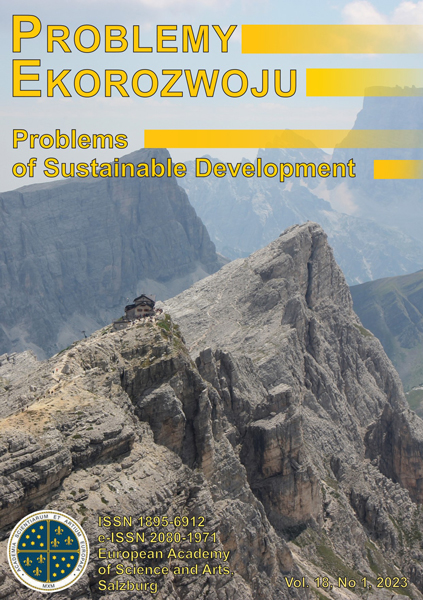BAŃKA A., 2002, Społeczna psychologia środowiskowa, Wydawnictwo Naukowe Scholar, Warszawa.
BIŃCZYK E., 2018, Epoka człowieka. Retoryka i marazm antropocenu, Wydawnictwo Naukowe PWN, Warszawa.
BOŁDYREW A., 2009, Recepcja teorii ludności T.R. Malthusa w polskiej myśli społecznej na przełomie XIX i XX w., Studia z Historii Społeczno-Gospodarczej XIX i XX Wieku, 6, Wydawnictwo Uniwersytetu Łódzkiego.
DOI: https://doi.org/10.18778/2080-8313.06.02
BRIGGS J.C., 2017, Emergence of a sixth mass extinction?, Biological Journal of the Linnean Society, 122 (2): 243-248.
DOI: https://doi.org/10.1093/biolinnean/blx063
BUKRAJEWSKI P., LATAWIEC A., MATUSZEWSKA A., 2019, Sustainable Development – Utopia or Implementa-tion Possibilities, Problemy Ekorozwoju/ Problems of Sustainable Development, 14(2): 111-116.
CARROLL L., 1999, Through the Looking-Glass, Dover Publications Inc.
CEBALLOS G., EHRLICH P.R., RAVEN P.H., 2020, Vertebrates on the brink as indicators of biological annihilation and the sixth mass extinction, PNAS, 117 (24): 13596- 13602.
DOI: https://doi.org/10.1073/pnas.1922686117
CHMARA R., 2019, Posthumanistyczny wymiar ekologii, Sztuka i Dokumentacja, 20: 105-112.
CISZEK M., 2020, The Philosophy of Perceiving the Human Environment from the Perspective of Environmental Social Psychology and Environmental Sociology (Implications for Sustainable Environmental and Health Security), Problemy Ekorozwoju/ Problems of Sustainable Development, 15(2): 211-222.
DOI: https://doi.org/10.35784/pe.2020.2.21
COWIE R.H., BOUCHET P., FONTAINE B., 2022, The Sixth Mass Extinction: fact, fiction or speculation?, Biological Reviews, 97: 640-663.
DOI: https://doi.org/10.1111/brv.12816
CRUTZEN P.J., STOERMER E.F., 2000, The Anthropocene, IGBP Global Change Newsletter 41: 17-18.
DECAESTECKER E., GABA S., RAEYMAEKERS J.A., STOKS R., Van KERCKHOVEN L., EBERT D., DE MEESTER L., 2007, Host-parasite ‘Red Queen’ dynamics archived in pond sediment, Nature, 450: 870-873.
DOI: https://doi.org/10.1038/nature06291
DONALD P.F., PISANO G., RAYMENT M.D., PAIN D.J., 2002, The Common Agricultural Policy, EU enlargement and the conservation of Europe’s farmland birds, Agriculture, Ecosystems and Environment, 89: 167-182.
DOI: https://doi.org/10.1016/S0167-8809(01)00244-4
DUELLI P., OBRIST M.K., 2003, Regional biodiversity in an agricultural landscape: the contribution of seminatural habitat islands, Basic and Applied Ecology, 4: 129-138.
DOI: https://doi.org/10.1078/1439-1791-00140
EDWARDS P.J., KOLLMANN J., WOOD D., 1999, The agroecosystem in the landscape: implications for biodiversity and ecosystem function, Agrobiodiversity: Characterization, Utilization and Management, eds. Wood D., Lenné J.M., CAB International,Wallingford, UK.
GECOW A., 2014, Znaczenie perspektywy opisu i wyjaśniania w Biological Turn. Perspektywa informacji celowej w biologii i humanistyce jako podstawa memetyki, Teksty z Ulicy, Zeszyt memetyczny, 15: 27-40.
KOLBERT E., 2014, The Sixth Extinction. An Unnatural History, Henry Holt and Company, New York.
KREBS J.R., WILSON J.D., BRADBURY R.B., SIRIWARDENA G.M., 1999, The second silent spring?, Nature, 400: 611-612.
DOI: https://doi.org/10.1038/23127
KROKOS J., 1997, Leksykon filozofii klasycznej, Studia Philosophiae Christianae, ed. Herbut J., 34 (1): 1-146.
KWAŚNICKI W., 2021, The role of diversity and tolerance in economic development, Journal of Evolutionary Econom-ics, 31: 821-851.
DOI: https://doi.org/10.1007/s00191-020-00715-2
KRZANOWSKA H., ŁOMNICKI A., RAFIŃSKI J., SZARSKI H., SZYMURA J., 1997, Zarys mechanizmów ewolu-cji, Wydawnictwo Naukowe PWN, Warszawa.
MCKIBBEN B., 2006, The End of Nature, Penguin Random House Inc.
MESCHEDE C., 2020, The Sustainable Development Goals in Scientific Literature: A Bibliometric Overview at the Meta-Level, Sustainability, 12(4461): 1-14.
DOI: https://doi.org/10.3390/su12114461
MITRA S., SAMEER A., 2022, Storytelling for Behavior Change: Use of Folktales for Promoting Sustainable Behaviors, Problemy ekorozwoju/ Problems of Sustainable Development, 17(2): 243-247.
DOI: https://doi.org/10.35784/pe.2022.2.26
MORTON T., 2016, Dark Ecology: For a Logic of Future Coexistence, Columbia University Press.
DOI: https://doi.org/10.7312/mort17752
MUSIAŁ W., MUSIAŁ K., 2021, Zastosowanie metody analogii dla poszukiwania wspólnych obszarów poznania w biologii i ekonomii (Using the analogy method to search for common areas of learning in biology and economy), Wy-dawnictwo Uniwersytetu Rolniczego, Kraków.
OLEJARZ J., IWASA Y., KNOLL A.H., NOWAK M.A., 2021, The Great Oxygenation Event as a consequence of ecological dynamics modulated by planetary change, Nature Communications, 12 (3985): 1-9.
DOI: https://doi.org/10.1038/s41467-021-23286-7
POLAK G., KRUPIŃSKI J., MARTYNIUK E., CALIK J., KAWĘCKA A., KRAWCZYK J., MAJEWSKA A., SI-KORA J., SOSIN-BZUCHA E., SZYNDLER-NĘDZA M., TOMCZYK-WRONA I., 2021, The risk status of polish local breeds under conservation programs – new approach, Annals of Animal Science, 21(1): 125-140.
DOI: https://doi.org/10.2478/aoas-2020-0071
RIDLEY M., 1993, The Red Queen. Sex and the Evolution of Human Nature, Viking Books.
ROBINSON R., SUTHERLAND W.J., 2002, Postwar changes in arable farming and biodiversity in Great Britain, Jour-nal of Applied Ecology, 39: 157-176.
DOI: https://doi.org/10.1046/j.1365-2664.2002.00695.x
SAMPAIO E., SECO M.C., ROSA R., GINGINS S., 2020. Octopuses punch fishes during collaborative interspecific hunting events, Ecology, 102 (3): 1-4.
DOI: https://doi.org/10.1002/ecy.3266
SOLE R., 2022, Revisiting Leigh Van Valen᾽s 'A New Evolutionary Law' (1973), Biological Theory, 17: 120-125.
DOI: https://doi.org/10.1007/s13752-021-00391-w
STEFFEN W., CRUTZEN P.J., MCNEILL J.R., 2007. The Anthropocene: Are humans now overwhelming the great forces of Nature?, AMBIO: A Journal of the Human Environment, 36 (8): 614-621.
DOI: https://doi.org/10.1579/0044-7447(2007)36[614:TAAHNO]2.0.CO;2
STROTZ L.C., SIMOES M., GIRARD M.G., BREITKREUZ L., KIMMIG J., LIEBERMAN B.S., 2018, Getting somewhere with the Red Queen: chasing a biologically modern definition of the hypothesis, Biology Letters, 14 (20170734): 1- 7.
DOI: https://doi.org/10.1098/rsbl.2017.0734
SZAFER W., 1959, Narodziny myśli o ewolucji organizmów w stulecie dzieła Karola Darwina ‘O powstawaniu gatun-ków’, Kosmos, 8 (3): 213-233.
SZTUMSKI W., 2021, Reflection on the Human Living Environment in Connection with Sustainable Development, Prob-lemy Ekorozwoju/ Problems of Sustainable Development, 16(1): 39-44.
DOI: https://doi.org/10.35784/pe.2021.1.04
SZYNDLER J., 2022, Towards Co-existence. Responsibility in the Anthropocene Debate, Problemy Ekorozwoju/ Prob-lems of Sustainable Development, 17(2): 24-30.
DOI: https://doi.org/10.35784/pe.2022.2.03
THOMAS C.D., 2017, Inheritors of the Earth: How Nature Is Thriving in an Age of Extinction, Public Affairs, New York
WEINER J., 1999, Życie i ewolucja biosfery, Wydawnictwo Naukowe PWN, Warszawa.
WEINER J., 2001, Czy niszczenie różnorodności ekologicznej stanowi zagrożenie cywilizacyjne?, Prace Komisji Zagro-żeń Cywilizacyjnych, PAU: 7-20.
VAN VALEN L., 1973, A new evolutionary law, Evol. Theory, 1: 1-30.
ZALEGA T., 2015, Ekonomia ewolucyjna jako jeden z nurtów współczesnej ekonomii – zarys problematyki. Studia i Materiały, Wydział Zarządzania Uniwersytetu Warszawskiego, 2: 157-177.
DOI: https://doi.org/10.7172/1733-9758.2015.19.12







